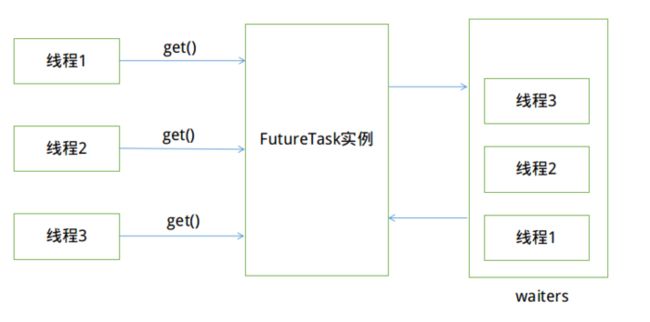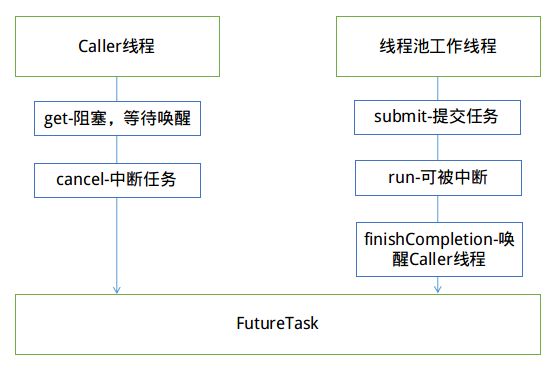【转自】http://www.jianshu.com/p/f624934b9a23
线程池的执行原理,主要关于线程池的生命周期和任务如何在池里创建、运行和终止。不过上次研究的是execute方法,执行的是Runnable任务,它不返回任何值。如果希望任务完成后返回结果,那么需要使用Callable接口,这也是本文要研究的主题。
ExecutorService es = Executors.newSingleThreadExecutor();
Future task = es.submit(new MyThread());
try {
//限定时间获取结果
task.get(5, TimeUnit.SECONDS);
} catch (TimeoutException e) {
//超时触发线程中止
System.out.println("thread over time");
} catch (ExecutionException e) {
//抛出执行异常
throw e;
} finally {
//如果任务还在运行,执行中断
boolean mayInterruptIfRunning = true;
task.cancel(mayInterruptIfRunning);
}
上面代码是Future的一个简单例子:MyThread实现Callable接口,执行时要求在限定时间内获取结果,超时执行会抛出TimeoutException,执行异常会抛出ExecutionException。最后在finally里,如果任务还在执行,就进行取消;如果任务已经执行完,取消操作也没有影响。
Future接口代表一个异步任务的结果,提供了相应方法判断任务是否完成或者取消。从图1可知,RunnableFuture同时继承了Future和Runnable,是一个可运行、可知结果的任务,FutureTask是具体的实现类。
FutureTask的状态
private volatile int state;
private static final int NEW = 0;
private static final int COMPLETING = 1;
private static final int NORMAL = 2;
private static final int EXCEPTIONAL = 3;
private static final int CANCELLED = 4;
private static final int INTERRUPTING = 5;
private static final int INTERRUPTED = 6;
FutureTask有7种状态,初始状态从NEW开始,状态转换路径可以归纳为图2所示。在后文的代码,会使用int的大小比较判断状态处于哪个范围,需要留意上面状态的排列顺序。
[图片上传失败...(image-f7d0b4-1513077081753)]
FutureTask的状态路径,取决于run和cancel的调用顺序,在后文分析时,对号入座这几条路径。
NEW -> COMPLETING -> NORMAL 正常的流程
NEW -> COMPLETING -> EXCEPTIONAL 异常的流程
NEW -> CANCELLED 被取消流程
NEW -> INTERRUPTING -> INTERRUPTED 被中断流程
FutureTask的变量
int state
Thread runner
WaitNode waiters
Callable
callable Object outcome
state、runner、waiters三个变量没有使用原子类,而是使用Unsafe对象进行原子操作。代码中会见到很多形如compareAndSwap的方法,入门原理可以看我以前写的认识非阻塞的同步机制CAS。
callable是要执行的任务,runner是执行任务的线程,outcome是返回的结果(正常结果或Exception结果)
static final class WaitNode {
volatile Thread thread;
volatile WaitNode next;
WaitNode() { thread = Thread.currentThread(); }
}
waiters的数据结构是WaitNode,保存了Thread和下个WaitNode的引用。waiters保存了等待结果的线程,每次操作只会增减头,所以是一个栈结构,详细见后文对get方法的分析。
FutureTask的创建
public FutureTask(Callable callable) {
if (callable == null)
throw new NullPointerException();
this.callable = callable;
this.state = NEW; // ensure visibility of callable
}
public FutureTask(Runnable runnable, V result) {
this.callable = Executors.callable(runnable, result);
this.state = NEW; // ensure visibility of callable
}
FutureTask可以接受Callable或者Runnable,state从NEW开始。如果是Runnable,需要调用Executors.callable转成Callable,返回的结果是预先传入的result。转换过程使用一个实现了Callable的RunnableAdapter包装Runnable和result,代码比较简单。
static final class RunnableAdapter implements Callable {
final Runnable task;
final T result;
RunnableAdapter(Runnable task, T result) {
this.task = task;
this.result = result;
}
public T call() {
task.run();
return result;
}
}
提交FutureTask到线程池的submit定义在AbstractExecutorService,根据入参的不同,有三个submit方法。下面以提交Callable为例:
public Future submit(Callable task) {
if (task == null) throw new NullPointerException();
RunnableFuture ftask = newTaskFor(task);
execute(ftask);
return ftask;
}
protected RunnableFuture newTaskFor(Callable callable) {
return new FutureTask(callable);
}
FutureTask在newTaskFor创建,然后调用线程池的execute执行,最后返回Future。获取Future后,就可以调用get获取结果,或者调用cancel取消任务。
FutureTask的运行
FutureTask实现了Runnable,在线程池里执行时调用的方法是run。
public void run() {
//1
if (state != NEW ||
!UNSAFE.compareAndSwapObject(this, runnerOffset,null, Thread.currentThread()))
return;
//2
try {
Callable c = callable;
if (c != null && state == NEW) {
V result;
boolean ran;
try {
result = c.call();
ran = true;
} catch (Throwable ex) {
result = null;
ran = false;
setException(ex);
}
if (ran)
set(result);
}
} finally {
//3
runner = null;
int s = state;
if (s >= INTERRUPTING)
handlePossibleCancellationInterrupt(s);
}
}
标记1处检查FutureTask的状态,如果不是处于NEW,说明状态已经进入四条路径之一,也就没有必要继续了。如果状态是NEW,则将执行任务的线程交给runner。
标记2处开始正式执行任务,调用call方法获取结果,没有异常就算成功,最后执行set方法;出现异常就调用setException方法。
标记3处,无论任务执行是否成功,都需要将runner重新置为空。
protected void set(V v) {
if (UNSAFE.compareAndSwapInt(this, stateOffset, NEW, COMPLETING)) {
outcome = v;
UNSAFE.putOrderedInt(this, stateOffset, NORMAL); // final state
finishCompletion();
}
}
protected void setException(Throwable t) {
if (UNSAFE.compareAndSwapInt(this, stateOffset, NEW, COMPLETING)) {
outcome = t;
UNSAFE.putOrderedInt(this, stateOffset, EXCEPTIONAL); // final state
finishCompletion();
}
}
任务执行成功与失败,分别对应NEW -> COMPLETING -> NORMAL和NEW -> COMPLETING -> EXCEPTIONAL两条路径。这里先将状态修改为中间状态,再对结果赋值,最后再修改为最终状态。
private void finishCompletion() {
// assert state > COMPLETING;
for (WaitNode q; (q = waiters) != null;) {
if (UNSAFE.compareAndSwapObject(this, waitersOffset, q, null)) {
for (;;) {
Thread t = q.thread;
if (t != null) {
q.thread = null;
LockSupport.unpark(t);
}
WaitNode next = q.next;
if (next == null)
break;
q.next = null; // unlink to help gc
q = next;
}
break;
}
}
done();
callable = null; // to reduce footprint
}
最后调用finishCompletion执行任务完成,唤醒并删除所有在waiters中等待的线程。done方法是空的,供子类实现,最后callable也设置为空。
FutureTask还有个runAndReset,逻辑和run类似,但没有调用set方法来设置结果,执行完成后将任务重新初始化。
protected boolean runAndReset() {
if (state != NEW ||
!UNSAFE.compareAndSwapObject(this, runnerOffset,
null, Thread.currentThread()))
return false;
boolean ran = false;
int s = state;
try {
Callable c = callable;
if (c != null && s == NEW) {
try {
c.call(); // don't set result
ran = true;
} catch (Throwable ex) {
setException(ex);
}
}
} finally {
// runner must be non-null until state is settled to
// prevent concurrent calls to run()
runner = null;
// state must be re-read after nulling runner to prevent
// leaked interrupts
s = state;
if (s >= INTERRUPTING)
handlePossibleCancellationInterrupt(s);
}
return ran && s == NEW;
}
FutureTask的取消
对于已经提交执行的任务,可以调用cancel执行取消。
public boolean cancel(boolean mayInterruptIfRunning) {
//1
if (!(state == NEW &&
UNSAFE.compareAndSwapInt(this, stateOffset, NEW,
mayInterruptIfRunning ? INTERRUPTING : CANCELLED)))
return false;
try { // in case call to interrupt throws exception
//2
if (mayInterruptIfRunning) {
try {
Thread t = runner;
if (t != null)
t.interrupt();
} finally { // final state
UNSAFE.putOrderedInt(this, stateOffset, INTERRUPTED);
}
}
} finally {
finishCompletion();
}
return true;
}
标记1处判断任务状态,为NEW才能被取消。如果mayInterruptIfRunning是true,代表任务需要被中断,走NEW -> INTERRUPTING -> INTERRUPTED流程。否则代表任务被取消,走NEW -> CANCELLED流程。
标记2处理任务被中断的情况,这里仅仅是对线程发出中断请求,不确保任务能检测并处理中断,详细原理去看Java的中断机制。
最后调用finishCompletion完成收尾工作。
public boolean isCancelled() {
return state >= CANCELLED;
}
判断任务是否被取消,具体逻辑是判断state >= CANCELLED,包括了被中断一共两条路径的结果。
FutureTask获取结果
调用FutureTask的get方法获取任务的执行结果,可以阻塞直到获取结果,也可以限制范围时间内获取结果,否则抛出TimeoutException。
public V get() throws InterruptedException, ExecutionException {
int s = state;
if (s <= COMPLETING)
s = awaitDone(false, 0L);
return report(s);
}
public V get(long timeout, TimeUnit unit)
throws InterruptedException, ExecutionException, TimeoutException {
if (unit == null)
throw new NullPointerException();
int s = state;
if (s <= COMPLETING &&
(s = awaitDone(true, unit.toNanos(timeout))) <= COMPLETING)
throw new TimeoutException();
return report(s);
}
get的核心实现调用了awaitDone,入参为是否开启时间限制和最大的等待时间。
private int awaitDone(boolean timed, long nanos)
throws InterruptedException {
final long deadline = timed ? System.nanoTime() + nanos : 0L;
WaitNode q = null;
boolean queued = false;
for (;;) {
if (Thread.interrupted()) {
removeWaiter(q);
throw new InterruptedException();
}
int s = state;
if (s > COMPLETING) { //1
if (q != null)
q.thread = null;
return s;
}
else if (s == COMPLETING) // cannot time out yet //2
Thread.yield();
else if (q == null) //3
q = new WaitNode();
else if (!queued) //4
queued = UNSAFE.compareAndSwapObject(this, waitersOffset,
q.next = waiters, q);
else if (timed) { //5
nanos = deadline - System.nanoTime();
if (nanos <= 0L) {
removeWaiter(q);
return state;
}
LockSupport.parkNanos(this, nanos);
}
else //6
LockSupport.park(this);
}
}
awaitDone主要逻辑是一个无限循环,首先判断线程是否被中断,是的话移除waiter并抛出中断异常。接下来是一串if-else,一共六种情况。
判断任务状态是否已经完成,是就直接返回;
任务状态是COMPLETING,代表在set结果时被阻塞了,这里先让出资源;
如果WaitNode为空,就为当前线程初始化一个WaitNode;
如果当前的WaitNode还没有加入waiters,就加入;
如果是限定时间执行,判断有无超时,超时就将waiter移出,并返回结果,否则阻塞一定时间;
如果没有限定时间,就一直阻塞到下次被唤醒。
LockSupport是用来创建锁和其他同步类的基本线程阻塞原语。park和unpark的作用分别是阻塞线程和解除阻塞线程。
private V report(int s) throws ExecutionException {
Object x = outcome;
if (s == NORMAL)
return (V)x;
if (s >= CANCELLED)
throw new CancellationException();
throw new ExecutionException((Throwable)x);
}
最后get调用report,使用outcome返回结果。
看图3,如果多个线程向同一个FutureTask实例get结果,但FutureTask又没有执行完毕,线程将会阻塞并保存在waiters中。待FutureTask获取结果后,唤醒waiters等待的线程,并返回同一个结果。
总结
图4归纳了FutureTask的作用,任务的调用线程Caller和线程池的工作线程通过FutureTask交互。对比线程池的执行原理,FutureTask是比较简单的。


